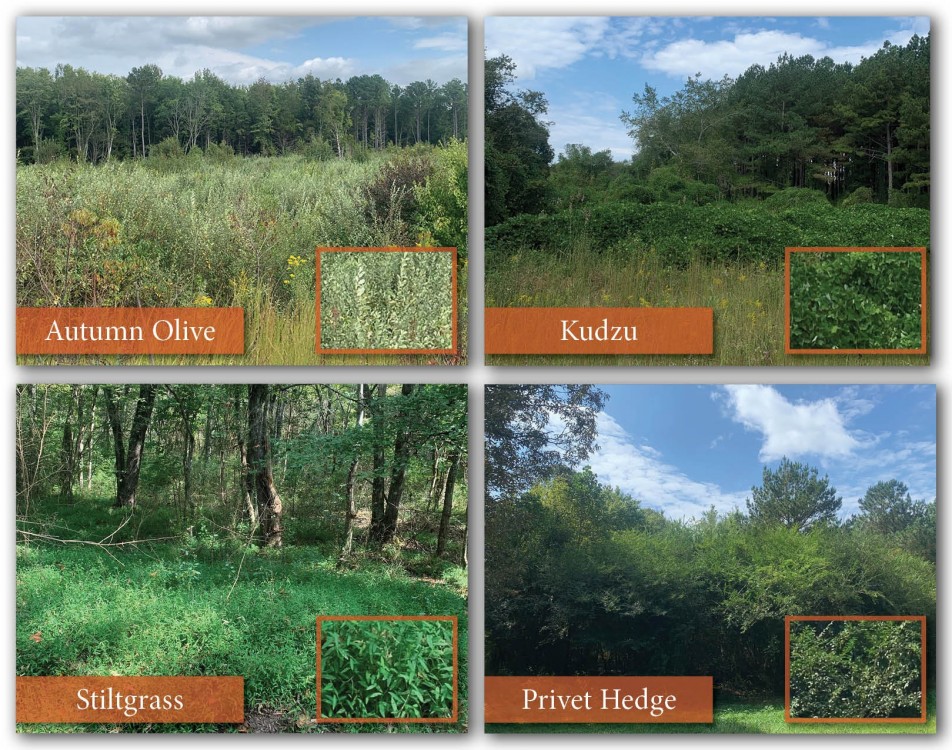ARNOLD AIR FORCE BASE, Tenn. – Intruder alert! Aliens have been spotted at Arnold Air Force Base. Although these beings are unable to communicate directly with installation staff, their objectives are clear. The interlopers wish to spread quickly and overtake established lifeforms in the area.
The “aliens” in this case are the invasive species, particularly exotic plants, that have taken root at Arnold. While these aliens lack the flying saucers and ray guns prevalent in science fiction books, shows and movies, the invaders from afar remain a significant threat.
Now is an opportune time to broach the subject of invasive species as this year National Invasive Species Awareness Week runs from Feb. 20 to Feb. 26. This annual event aims to raise public awareness about the negative impacts of invasive species and promote ways to reduce their spread.
The U.S. Geological Survey defines an invasive species as an introduced, nonnative organism – disease, parasite, plant or animal – that begins to spread or expand its range from the site of its original introduction and has the potential to cause harm to the environment, the economy or human health. Traits of invasive species include fast growth, rapid reproduction, ease of dispersal and adaptability to varying environments.
Before he joined the team of natural resource specialists at Arnold Air Force Base, Mark Winland battled feral hogs in the Florida Panhandle, working to limit destruction to wetlands and endangered species breeding habitats caused by the invasive beasts.
Winland is now intent on controlling the damage created by invasives at Arnold. His focus has shifted from taking on savage swine to tackling botanical bullies, but the problems invasive plants impose upon the natural world, including ecosystems across Arnold AFB, are just as serious.
“In the natural resource field, it’s kind of become commonly accepted that invasive species present one of the bigger threats to natural resources,” Winland said. “They have the potential to alter landscapes permanently.”
The forests and other habitats located across the thousands of acres comprising Arnold AFB are hardly immune to invasives. Some of the most prominent invasive plant species found at Arnold include the autumn olive, privet, kudzu, multifloral rose, Japanese stiltgrass, Johnson grass and tree-of-heaven.
To weed out these unwanted guests before they take a substantial toll on native plant life, natural resource specialists at Arnold rely primarily on chemical treatments and will utilize these in conjunction with tools to remove larger invasives.
“Primarily, the stuff we treat around here are shrubs and forbs, herbaceous-type vegetation, but if we have really big trees that we’re treating it’ll be a combination of the two, mechanical and herbicide,” Winland said. “You cut the stump down then you treat it with herbicide. That’s basically modifying the plant structure in a way that the herbicide is most effective. Our goal is to use as little herbicide as humanly possible.”
Over the spring and summer of 2022, approximately 1,400 acres were treated for infestations across Arnold AFB. Treatments occurred throughout the base but were most concentrated around areas managed as barrens habitat.
Control can prove difficult, often requiring years of repeated treatments to eradicate all invasives in an area.
The natural resource staff at Arnold is always on the lookout for invasive plants. A key reason to nip undesirable vegetation in the bud before bigger problems sprout is the detrimental economic impact associated with invasives. According to Winland, it is estimated that invasive plants cause approximately $20 billion in economic damages across the U.S. each year.
Along with the monetary ramifications, invasive species can also inflict considerable harm to the environments in which they colonize. Invasive plants can displace native flora, adversely affecting wildlife cover, food webs and natural processes within the ecosystem.
“Depending on the species, invasive plants tend to create a monoculture,” Winland said. “They will actually outcompete everything else, and you’ll go from having a nice, diverse understory to having privet hedge. And while privet hedge can still provide some wildlife benefits – provide a little bit of cover and a food source in the seed – as a whole, it goes from being useful for all wildlife to just a couple of wildlife being able to benefit from it.”
And, as history has shown, the introduction of an invasive species can lead to destruction on a greater scale. The chestnut blight of the early 1900s is one such example. At that time, the chestnut tree was a dominant presence in forests throughout the eastern U.S. It was also around this time that Japanese chestnut trees were brought to the U.S.
These imported trees were not the invasive species; rather, the invasive was the parasitic fungus of East Asian origin carried on the plants. American chestnuts were highly susceptible to this fungus and, by 1940, chestnut blight caused by it had virtually wiped out all mature chestnut trees in the U.S. Billions of trees were killed by the disease and the American chestnut has not recovered.
More often than not, Winland said, the introduction of invasive plants to an area, whether purposely or accidentally, is associated with human activity. Because of this, natural resource personnel at Arnold often have a good starting point when surveying the base for invasives.
“You typically have a pretty good idea of where your high-priority areas are going to be,” Winland said. “A good example is if you’re doing road work and you’re grading and creating fresh soil or you’re bringing in fill material from the outside, that’s always a good place to keep an eye out for invasives.
“Being an invasive, they’re an early colonizer so they’ll be one of the first things that kind of takes over that fresh dirt. Anytime you’re bringing in outside material – firewood, mulch, dirt, hay, anything like that – there’s always a chance for seed.”
Invasive plants can also take over lawns and gardens. To combat invasive plants, Winland encouraged property owners to educate themselves on invasives to recognize such plants more easily and learn about ways to manage them.
“The big thing is to identify it and then, ideally, start working with a qualified, knowledgeable individual to figure out your treatment plan,” he said. “It’s also important to understand how invasive species will spread on your property. If you’re in your backyard and you see Japanese stiltgrass, a common invasive, just by mowing it you are spreading that infestation. Everywhere that mower goes you’ll be spreading that infestation.
“Things that happen in your yard, they affect the landscape as a whole.”
The Tennessee Invasive Plant Council maintains an online resource which includes information and photos that individuals can use to familiarize themselves with invasive plants found throughout the state. The council’s list can be found at https://www.tnipc.org/invasive-plants/.
Resources are also available through some state agencies and the U.S. Department of Agriculture to advise individuals on how to best treat established plant infestations.
A burgeoning method for property owners to combat invasive plants is to remove them and replace them with native species. Winland said there are programs that will assist those looking at this option by offering reduced prices on native trees and shrubs to plant.
Hunters and other outdoor recreationists are urged to clean boots, tents, apparel and vehicles to prevent the spread of invasives.
“You may have seeds hitchhiking,” Winland said. “Clean your ATVs, your 4-wheelers, UTVs. If you’re taking your truck offroad way back in the backcountry, you can be transporting invasive species in your truck and not even know it. Dog fur has been known to carry invasives. Basically, anything that plant material can stick to can become a source.”
It is also recommended that heavy equipment, tractors, implements and mowing and landscaping equipment be cleaned between yards or projects.
Winland said everyone has a part to play in limiting the introduction and spread of invasive plants.
“We hope we can eradicate invasive species, but sometimes control is the best we can hope for, to limit the spread,” Winland said. “It’s like the old adage says: ‘An ounce of prevention is better than a pound of cure.’ Once they’re here, it’s really, really hard to get rid of them. Your best bet is to make sure they never show up.”
Invasive plants are the primary concern at Arnold, but invasive insects are also a source of consternation for natural resource personnel. One such pernicious pest is the emerald ash borer. These small green beetles of Asian origin lay their eggs in the crevices of ash trees. The larvae bore into the tree to feed underneath the bark before emerging as adults around a year later. The damage caused by the pre-adult feeding impedes the ability of the tree to transport water and nutrients, essentially starving the plant.
The insect is responsible for destroying millions of ash trees across the country. Arnold AFB lies within the emerald ash borer containment zone.
“It can directly kill ash trees,” Winland said. “There’s a timber value to that. There’s a wildlife value to that. There’s a botanical and ecological value. It’s kind of hard to put a value on a lot of that.”
Arnold natural resource personnel are responsible for monitoring invasive species infestations, working to secure funding, implementing control projects and staying abreast of new and emerging threats. This includes keeping on their radar any invasive fauna that could find its way to the area. One such critter is the silver carp, which has already turned up in the Tennessee River and Cumberland River systems. These fish damage ecosystems by consuming small organisms required by native fish and mussels. They are also considered a danger to humans due to their propensity to jump out of the water when startled, a reaction often prompted by the sound of boat motors.
Winland said fishermen should take care to prevent silver carp from being introduced to the Elk River or other bodies of water near Arnold.
“You get anglers traveling from all over the country to fish. They could very easily and inadvertently bring something back to a waterbody around here,” he said. “That’s why it’s so important to drain your livewells, wash your boat, wash your trailer in between going to different bodies of water.”
Winland is also keeping tabs on an old nemesis.
“Feral hogs are not an issue on base, but you don’t have to go very far off to where they’re a huge issue,” he said. “They destroy hundreds of thousands, if not millions, of acres of native habitat across the country every year.”
The natural resource specialists continue to keep an eye out for potential invasives from the plant kingdom, such as the Bradford pear and cogongrass. Winland said vigilance is important, as the emergence of the next significant invasive could crop up at any time.
“What’s really scary about invasive species is we know what the current issues and threats are,” he said, “but you never know what else is out there waiting to explode.”
Additional WGNS News Headlines:
- Reducing Recidivism Rates in Prison
- 2021 Murder Case Heads to a Grand Jury
- GAS: The Price of Fuel This Week in Rutherford Co.
- Missing Murfreesboro Woman Safely Located
- Commentary by Commissioner Harris: Wokeism
- Apartment Rent in Rutherford County
- Funding Under the Cares Act Still Available






